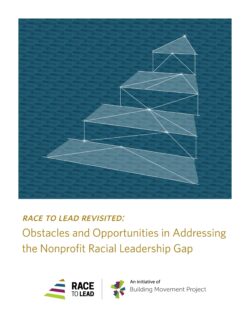Jun
17
2020
The Building Movement Project (BMP) is pleased to announce the release of Race to Lead Revisited: Obstacles and Opportunities in Addressing the Nonprofit Racial Leadership Gap. This is the first report based on data collected last summer from over 5,000 nonprofit staff from across the sector. The findings are especially relevant at this moment when nonprofit organizations are responding to the COVID-19 epidemic, the economic downturn, and the continued murders of Black people at the hands of police officers. This moment calls on nonprofits to not only release statements in support of the Movement for Black Lives, but to also contend with racial inequity within their own organizations.
In Race to Lead Revisited, we identify three key findings that challenge organizations and the sector to move towards achieving greater equity and inclusion:
1. The original report is still relevant three years later.
When we surveyed the sector in 2016, we found that people of color had similar leadership qualifications compared to white people, and were more likely to aspire to leadership than their white counterparts. But the data also showed that people of color faced systemic barriers and challenges as they sought to advance in their careers. Race to Lead Revisited reports similar findings with the gap between people of color and white respondents remaining the same or increasing.
2. There is a white advantage in the nonprofit sector.
We use the term “white advantage” to emphasize the concrete ways that structure and power in nonprofit organizations reinforce the benefits of whiteness. When comparing the quality of workplace experiences, we categorized nonprofits into three types: White-run (board and leadership is more than 75% white), POC-led (board and leadership is more than 50% people of color), and All Other (all other configurations, which generally skew white). We found that people of color working for White-run nonprofits have less positive experiences than white respondents, and that all staff do better in POC-led groups where the gaps between people of color and whites disappear.
3. Diversity, equity, and inclusion (DEI) efforts are widespread and their effectiveness is uncertain.
In the 2019 survey, we asked respondents to share their experiences of diversity, equity, and inclusion (DEI) efforts in the workplace, and to offer their views on how to increase organizational diversity. Nearly three-quarters of respondents reported DEI initiatives in their organizations, with trainings as the most common activity. DEI efforts appeared to increase awareness of issues of race, but did not always result in more equitable organizations.
Race to Lead Revisited concludes with a summary of lessons learned, by offering five opportunities and recommendations for change:
- Focus on structures and the experience of race and racism.
- Consistently model and reinforce the organization’s commitment to race equity.
- Fund more organizations led by people of color.
- Change organizational practices and policies to diversify the staff, leadership, and board.
- Commit to a DEI process, to transparency, and to measurable ways of assessing progress.
To learn more, read the full report.
To help us spread the word, check out our outreach and promotion materials here.
Also, check out our recent webinar recording, featuring Frances Kunreuther (Co-Director, BMP), Sean Thomas-Breitfeld (Co-Director, BMP), Margaret Mitchell (CEO & President of YWCA Greater Cleveland), Kerrien Suarez (Executive Director of Equity in the Center), and Edgar Villanueva (Senior Vice President of the Schott Foundation and author of Decolonizing Wealth).


